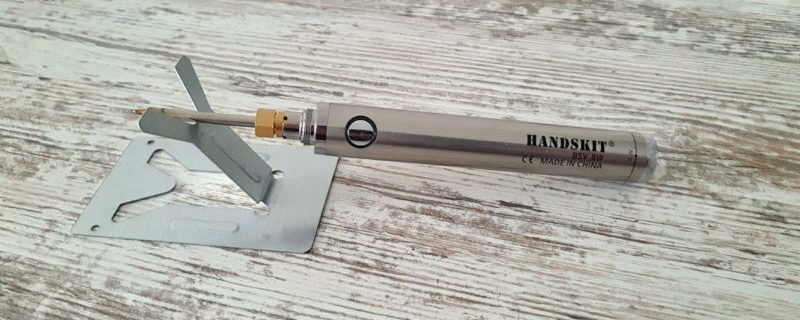Description and fabrication of a voltage indicator
When electrical equipment malfunctions, short circuits, sparks or broken wiring, it is not necessary to call an electrician. In most cases, you can do it yourself. For quick detection and correction of failures, you need a small-sized device - a voltage indicator. You can buy it in a store or make it yourself.
How a voltage indicator works
People often do not understand how the device works. The electrician or user sticks the tip of the device into one hole in the socket, then touches a metal plate on its body with his finger, and the LED (or neon bulb) lights up.
Topical video: Hidden features of the indicator screwdriver
But to turn on the lamp you need two conductors that carry current, and the indicator works by touching the sting of one end of the power cord or the contact of the socket. The secret is that the other wire in this case is the human body. It is one of the shells of a huge capacitor, the earth.
The phase current goes through the sting of the indicator to the resistance and then to the LED. When you touch the sensor plate connected to the second terminal of the semiconductor with your finger, zero potential is applied to it and the light source lights up.
Materials needed to make the indicator
To make a simple LED device that indicates phase or voltage (approximately), you need to find a working circuit. Then buy or get the following parts and tools:
- an LED of any type;
- a diode that opens with a current of 10-100 mA at a direct potential of 1 V, with a breakdown voltage (reverse) of at least 30-75 V;
- 100-200 kOhm resistor;
- bipolar transistors;
- soldering iron;
- wires;
- metal plate (can be cut out of a beer can);
- Plastic body, preferably transparent;
- A sting, you can take an ordinary nail.

Diagram of a phase indicator on LEDs
According to the figure, the device is assembled. A simple indicator to check the phase consists of 3 parts. It can be assembled in 5-10 minutes. Devices that can approximate the voltage contain transistors and special LEDs.
At 12 volts.
A 12 volt indicator circuit on LEDs for determining the voltage of a car charge contains 16 parts.

There are three voltage dividers in the device: on resistors, stabilitrons and transistors. Their outputs are connected to a tri-color LED.
Voltage (in volts) is determined by the color of its glow:
- red - more than 14.4;
- green - 12-14;
- blue - less than 11.5.
The indicator consists of the following parts:
- constant resistors R1, R3, R5 and R6 - 1, 10, 10 and 47 kOhm, respectively;
- potentiometers R2, R4 - 10 and 2,2 kOhm;
- VD1, VD2 and VD3 - 10, 8.2 and 5.6 V;
- bipolar transistors VT- VT3 type BC847C;
- RGB LED.
Using potentiometers R2, R4 the low and high voltage limits are set.
Topical video: How to make a hidden wire detector with your own hands from improvised materials
The circuit works as follows:
- when the input potential is low, transistor VT3 opens and VT2 closes (blue is lit);
- at nominal voltage current flows through the parts R5, VD3, R5 to the green crystal (VT2 is open and VT3 is closed);
- when the potential is high, the divider R1, VD1, R2, VT1 turns on and the red crystal lights up.
At 220 volts.
To protect yourself from electric shock, you need to put a resistor with a larger rating at the input of the indicator. The general circuit of the indicator is as follows:
- one lead of a 100-200 kOhm resistor is connected to the sting;
- to the other end solder the anode of the diode and the cathode of the LED;
- Their remaining legs are connected to a metal plate.

The diode in the circuit can be of KD521, KD503, KD522 type (analogs 1N914, 1N4148). To make a 220 volt LED voltage indicator with your own hands is within the power of any craftsman.
How to make a voltage indicator on LEDs
Most users assemble the phase indicator device inside a medical syringe. Its housing is transparent and you don't have to drill a hole to make the semiconductor light visible.

To make an indicator do the following:
- Disassemble the syringe.
- The sting is its needle. To it solder one end of the resistor and the other parts (according to the diagram).
- To the legs of the diode and LED, going to the plate, attach a thin wire and take it outside.
- Cut off the inside of the piston and insert it into the syringe.
- The wire is soldered to the plate.
- The plate is glued to the side of the housing or to the top of the piston.
Recommended for viewing: Options for making homemade testers
The battery voltage indicator is assembled by hinged mounting or on a board. It is inserted into a larger syringe or a suitable box, in which a hole is made for the LED. Two wires with clamps are soldered for connection to the battery.
At the end, use a voltage regulator and a multimeter to set the minimum and maximum voltage limits. This is how an indication is obtained.